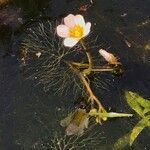Submersed leaves: petiole to 4 cm; leaf blade 1-3.5 × 1.5-5.5 cm, terminal segments 3-200, linear to slightly spatulate, to 1.8 mm wide. Floating leaves: blade 0.6-3 cm × 1-4 mm, margins entire or notched to sagittate at base. Flowers 6-15 mm diam.; sepals white to purplish [yellow] or with purple-tinged margins, 5-12 × 2-7 mm; petals colored as sepals but with proximal, yellow, nectar-bearing auricles, 4-12 × 2-5 mm, apex broadly obtuse or notched; stamens 3-6, mostly 6; pistils 2-4, mostly 3, divergent at maturity; ovules 3. Fruits 4-7 mm. Seeds 1-3, 1.5-3 × 1-1.5 mm, tubercles in 4 longitudinal rows. 2 n = ca. 78, ca. 104.
Stem to 2 m, branched; submersed lvs rotund, 2–5 cm wide, on petioles 1–3 cm; floating lvs few and small, linear-elliptic, 6–20 mm, commonly slightly constricted at the middle, often bifid at one end; peduncles 3–10 cm; sep and pet 6–12 mm, white with yellow base, the pet auriculate near the base; stamens 6; 2n=24. Ponds and quiet streams; N.J. to O., s. Mich., and Mo., s. to Fla. and Tex., and occasionally intr. farther north, as in Mass. and N.Y.
See var. caroliniana.

